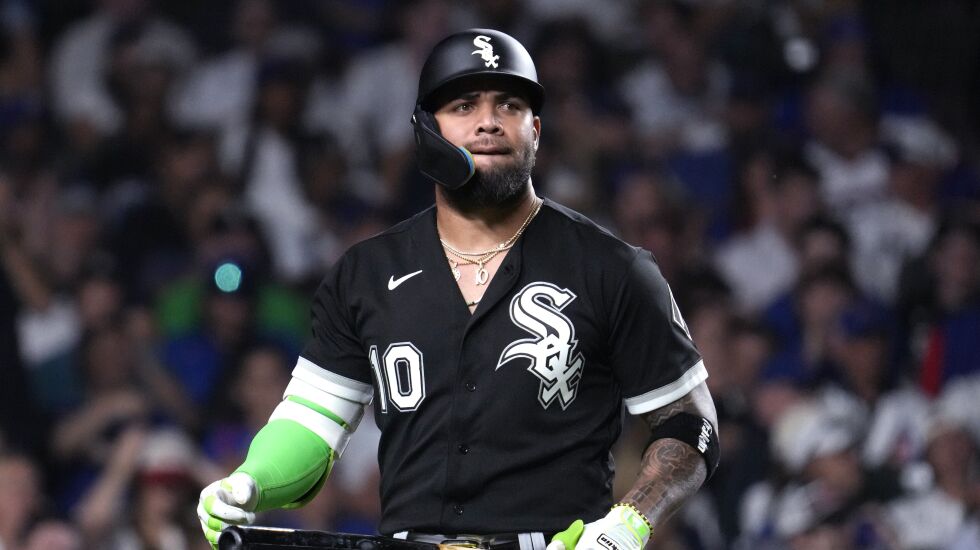
During one of his many productive seasons before leaving for Houston a year ago, former White Sox slugger Jose Abreu confessed of his aggressive plate approach: “I like to swing. It’s not a secret.”
The Sox retained Abreu’s madness but not his method. For the second straight season and the third in the last five years, they drew walks at the lowest rate in MLB.
It’s the furthest thing from a fluke.
According to FanGraphs, Sox hitters swung at pitches outside the strike zone and had strikes on the first pitch more often than any other team in 2023, and also had the seventh-lowest rate of pitches in the strike zone. It was the ninth time in the last 10 years their offense was in the bottom 10 in walk rate — making it a more of a question of how they ever established a coherent plate approach in 2021, when they won the division despite having the fourth-most walks in MLB, than of how it fell apart so quickly afterward with mostly the same players.
“We’ve got to shrink the strike zone,” manager Pedro Grifol said about once per week this past season.
Undisciplined Sox offenses are old hat, but 2023 also saw their pitching staff suffer the second-highest walk rate in MLB. While the miserable Athletics had the No. 1 spot in a chokehold, the 10.4% rate by Sox pitchers was the second-worst of any team since 2020. According to FanGraphs, Sox pitchers threw the second-fewest pitches in the strike zone and had the sixth-lowest chase rate by opposing hitters venturing outside it.
Former general manager Rick Hahn lamented the Sox’ issues controlling the strike zone in April while insisting the talent was there to win a championship. Pitching coach Ethan Katz postulated that early in the season, his staff was struggling to make quick mechanical adjustments to missed spots because of the introduction of the pitch clock, and that after the trade deadline, the Sox had an array of Triple-A call-ups.
But across the board, the Sox refuse to be constrained by the borders of the strike zone, and a quick and lasting turnaround seems daunting.
Every year, an MLB team or two in the bottom five in preventing or drawing walks — and usually one in the bottom five in both — will make the playoffs (for example, this year’s Marlins or last year’s Guardians). Those tend to be plainly rebuilding teams, such as last year’s Nationals or the 2021 Royals. And there are often repeat examples. In the last 10 years, the Marlins and Rockies have both done it twice, and the Sox did it in all three of their rebuilding seasons from 2017 to 2019. And thanks to the 60-game pandemic season in 2020 and MLB’s expanded playoffs, the 2020 Sox and Marlins (who went 31-29 with a negative-41 run differential) both qualified for the postseason a year after being in the bottom five in both issuing and drawing walks.
But the 2018 Braves — after replacing their general manager and pitching coach, and with Ronald Acuna Jr. and Ozzie Albies in their first full seasons and Dansby Swanson in his second — are the only true turnaround story in the last decade. They were coming out of a multiyear rebuild and haven’t let anyone else win the National League East since.
Having failed to find the same sustained success from their own long rebuild, the Sox have tasked themselves with rapidly creating the same level of transformation. The addition of senior pitching advisor Brian Bannister provides support to the pitching infrastructure of a team that lost coordinator Everett Teaford to Auburn this year. However, Sox rotation centerpieces Dylan Cease and Michael Kopech have battled walks their entire career. And in a classic case of pursuing the hair of the dog that bit them, the since-deposed Sox front office dealt for stuff-over-command prospects Nick Nastrini and Jake Eder.
Grifol came into 2023 touting the benefits of hitters taking simulated at-bats on pitching machines to improve their decision-making. And Luis Robert Jr. added just enough patience to have a Silver Slugger season.
But the Sox’ swing-first tendencies won out. Incremental progress in Andrew Vaughn’s swing decisions hasn’t translated yet to the walk rates he had as a top prospect. Oscar Colas’ debut season was ruined by impatience. And hitting coach Jose Castro was fired, replaced with Marcus Thames.
Top prospect Colson Montgomery, blessed with a brilliant batting eye throughout his minor-league run, is a promising way to start the new Sox core. But he and fellow prospects Bryan Ramos and Edgar Quero can only be the first steps in what has to be sweeping change to the typical Sox offensive profile. Few teams have struggled as badly to control the strike zone as the Sox have, and even fewer have quickly found answers.







